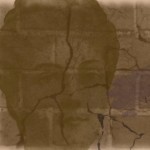Genealogy Reports and Charts
Family Tree: Understanding Cousin Relationships
June 4, 2012 by ramona
Filed under Articles, Genealogy Reports and Charts, Introduction to Genealogy, Latest News
 Relationship charts are a great tool for understanding your family tree…when you know how to use them. However, for the genealogy beginner they can be a little confusing.
Relationship charts are a great tool for understanding your family tree…when you know how to use them. However, for the genealogy beginner they can be a little confusing.
The purpose of a relationship chart is to help you identify the first common ancestor shared between you and a non-immediate family member such as a cousin.
For example, by looking at the first two rows of a family relationship chart you can see that the first common ancestor you share with a sibling is a parent, you share a grand parent with a niece or nephew and a great-grandparent with a great-niece or nephew.

This all seems straightforward until you start going down the chart and run into “cousins removed”. So what is a cousin “removed”? The easiest way to understand this is to think of it in terms of how many generations there are between first and second cousins and then go one-step further.
A first cousin is the child of an uncle or aunt and the first common ancestor you share is a grand parent.
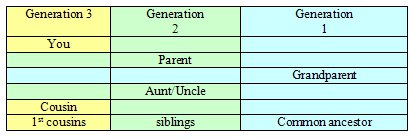
Second cousins are separated by another generation. Simply put second cousins are the children of first cousins. Both children are separated by two generations from their common ancestor.

To understand cousins once removed lets go that extra step. Your cousin once removed is a cousin of your parent.
- The common ancestor of you and your first cousin once removed are your great-grandparents
- There are two generations separating you from your great-grandparents (your parents and your grandparents)
- There is one generation separating your first cousin once removed from your great-grandparents (your great-uncle/aunt).
Since your parents cousin (your first cousin once removed) is one generation closer to your common ancestor there is one generation or “degree” of difference between the relationships you and the “cousin” share with the common ancestor.

One rule to help remember “removed” relationships are that there is always an unequal distance (grey squares) between the “removed” cousins and the common ancestor, while cousins that are not removed will have an equal distance (pink squares) between the common ancestor.
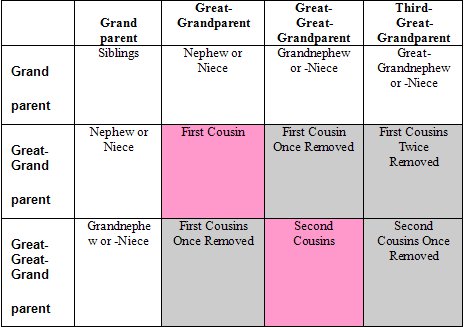
Did you know that in over ten generations you could have well over two thousand direct line ancestors?
Two parents + four grandparents + eight great-grandparents + sixteen great-great-grandparents + thirty two great-great-great-grandparents + sixty four great-great-great-great-grandparents + one hundred twenty eight great-great-great-great-great-grandparents + two hundred fifty six great-great-great-great-great-great-grandparents + five hundred twelve great-great-great-great-great-great-great-grandparents + 1,024 great-great-great-great-great-great-great-great-grandparents (2+4+6+8+16+32+64+128+512+1024) = 2046 direct ancestors in ten generations.
Sign up today for a Free Trial membership with Genealogy Beginner and you will receive a Family Relationship Chart as part of your Family Tree Starter Kit.
Brick Wall Breakthroughs for Genealogy Beginners
March 4, 2012 by ramona
Filed under Articles, Genealogy Reports and Charts, Introduction to Genealogy, Latest News, Lesson 3 Articles
Brick wall busting is all about problem solving and detective work. However before you can begin to break down your brick wall you need to define exactly what the problem is.
The top four most common causes of brick walls:
Your brick wall may even stem from a combination of the above and that can feel like an overwhelming challenge to the genealogy beginner. What you need are the tools and strategies to keep you from being overwhelmed and that is the first step towards solving your brick wall problem.
Developing Your Brick Wall Search Strategy
A good search strategy for brick walls comes down to initiating three core actions:
Review Genealogy Your Data
Even if you have looked over your data a hundred times…do it again. The reason for implementing this strategy is to find the holes or weak points in your brick wall. For example, large time gaps between children are a big red flag; they indicate an area you need to look into more intensely. Locating the areas where you have gaps in your information will give you leads.
Chart Your Genealogy Research
After you have reviewed your information, chart it. Charting your research will give you an overview that can help you analyze information and spot gaps. A records checklist is one of the best charting strategies, although there are several you can work from to help achieve your goals.
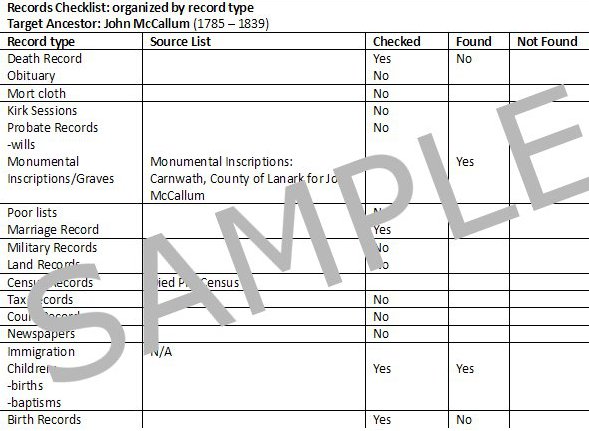
Map Your Locations
In addition to charting your research, another helpful search strategy is mapping. You may find that mapping your family tree will help you understand a little more about your ancestor’s lives as well as assist you in breaking down a brick wall.
Old Maps and Genealogy
Locating and using old maps can be a valuable resource for making a brick wall breakthrough.
- Understanding where county boundaries existed
- Noting border changes
- Discovering old place names that no longer exist
- Understanding the topography (through this you may learn how your ancestors traveled).
All of these things will point you in new directions and help you to discover record sources you may not otherwise consider. Additionally, knowing the lay of the land back then can lead you to the governing body that holds the records today.
Plotting Your Genealogy Research Map
Knowing your ancestors residences, where their children were born, where their spouse was born and where their relatives lived can help fill in gaps. The best way to develop a strong concept of this is to plot a map listing all of these locations.
Lanarkshire Map 1796
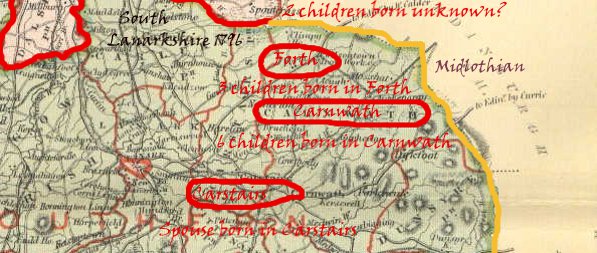
When you have finished plotting your historic map, plot a modern one, and then compare them for missing parishes or towns as well as county border changes.
Modern Lanarkshire Map
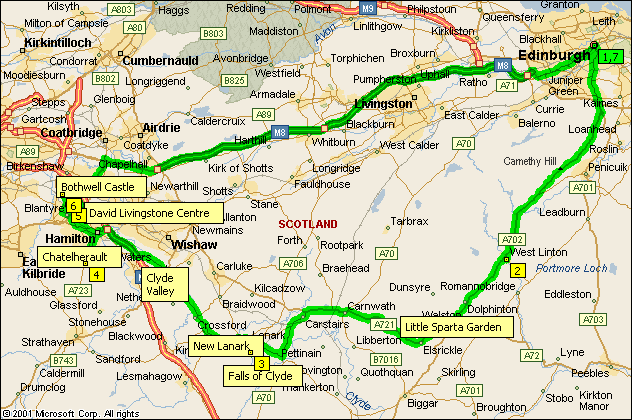
Once you have all of your information charted and mapped out, you will be prepared to make a full and comprehensive search that should help you break your brick wall.
Charting and mapping are only a few of the strategies you can use to help solve your brick wall problems. Genealogy Beginner will be bringing you more invaluable brick wall strategies very soon. For now, join us in the Ask a Genealogist forum and find more tips on charting your research.
Image Credit: Ramona Hartley
Making Family Trees – Tackling The 6-Generation Family Tree Chart
November 7, 2009 by Chris
Filed under Articles, Genealogy for Beginners, Genealogy Reports and Charts, Introduction to Genealogy
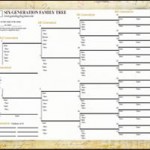 When making family trees it’s easy to get lost in the details. All those lines and dates, who’s generation one and where do your children go? My hope is that this blog post will get a discussion going around how to address these issues.The Six Generation Family Tree Template you downloaded has three key areas that you need to understand in order to complete your family tree:
When making family trees it’s easy to get lost in the details. All those lines and dates, who’s generation one and where do your children go? My hope is that this blog post will get a discussion going around how to address these issues.The Six Generation Family Tree Template you downloaded has three key areas that you need to understand in order to complete your family tree:
- Entry Numbers (representing people)
- Chart Number (used to sync 7+ generations)
- Birth, Married, and Death citations (represents your research)
Some folks are writing to say they’re having a hard time with these three areas. If this is the case for you than go ahead and use the comments area below to ask any specific questions. Also note that I’ve written a short yet detailed guide that you can use to complete your family tree chart.
It has four main sections:
- Mastering the Six-Generation Family Tree Chart
- Step-by-Step: Generations One Through Three
- Step-by-Step: Generations Four Through Six
- Seven Generations and Beyond
I’m calling it, “How to Complete a Family Tree Chart” and you’ll find it a great resource for getting things done.
It is extremely inexpensive and packed with photos and step-by-step instructions. I discuss every inch of the 6-generation family tree and promise it’ll answer every question you have about how to complete the chart.
(If there is a question or comment below that you have a good answer for, please don’t hesitate to chime in.)
About Genealogy Trees
June 2, 2009 by Chris
Filed under Articles, Blank Family Tree, Genealogy Reports and Charts, Introduction to Genealogy
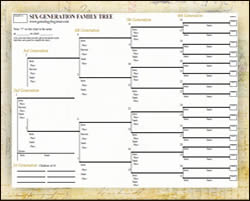 Picture this, you have gathered all of the information for your immediate family and grandparents and are ready to start documenting it. You have looked all over the internet and have found so many types of family tree charts that you are now completely overwhelmed. What type of tree should you use? My advice to the beginning genealogist is…for now… just keep it simple. Start off with your family group sheet and a basic six generation pedigree chart. At this point you do not need to go to any expense ( we have some complimentary ones to get you started just click the links above) as you still have so much research and learning ahead of you.
Picture this, you have gathered all of the information for your immediate family and grandparents and are ready to start documenting it. You have looked all over the internet and have found so many types of family tree charts that you are now completely overwhelmed. What type of tree should you use? My advice to the beginning genealogist is…for now… just keep it simple. Start off with your family group sheet and a basic six generation pedigree chart. At this point you do not need to go to any expense ( we have some complimentary ones to get you started just click the links above) as you still have so much research and learning ahead of you.
You don’t need more than a simple, easy to follow, straight forward form. As you continue with your research you will gain a better idea of exactly what chart you want to use for presentation purposes.
The chart you use while documenting your initial findings should be:
- Simple,
- Well laid out
- Clean in design
So you can easily record your information onto it in a way that will be understandable in the future, when I was just beginning having lots of space for writing was an important factor. A six generation chart will work well for that purpose. Later, as your family tree expands, so can the size of your pedigree chart and as your experience grows you will find larger charts more manageable and easy to read.
Find out Genealogy Trees
How to Make a Family Tree?
May 19, 2009 by Chris
Filed under Articles, Genealogy for Beginners, Genealogy Reports and Charts, Introduction to Genealogy
 Are you curious about your long lost relatives? You can easily find out about them with technologies that help you create a family tree. Do you want to know how to make a family tree ? A family tree is an account of your forefathers. Usually it is depicted by a genealogy map that shows family connections. Such a record usually contains vital information such as names of ancestors, their dates of birth, place of origin and occupation. Each person is connected to other people via different lines that designate different relationships.
Are you curious about your long lost relatives? You can easily find out about them with technologies that help you create a family tree. Do you want to know how to make a family tree ? A family tree is an account of your forefathers. Usually it is depicted by a genealogy map that shows family connections. Such a record usually contains vital information such as names of ancestors, their dates of birth, place of origin and occupation. Each person is connected to other people via different lines that designate different relationships.
For the data required to build a family tree, you may seek assistance from relatives or even from the internet. Grow your research as you grow your tree,visit make a family tree.
How to Make a Family Tree Chart
January 5, 2009 by Chris
Filed under Blank Family Tree, Genealogy Reports and Charts, Introduction to Genealogy
 I received an email today where someone who had previously downloaded a family tree chart had written:
I received an email today where someone who had previously downloaded a family tree chart had written:
“Personally what I have trouble with is where to put people on the tree. Is each tree for each branch of the family? For instance, my husband has 3 siblings, my father-in-law has 3 siblings. Where do I stop on the tree? Having the cousins listed is important.”
This is such a comment type of question (and something that drove me crazy when I was first starting trying to figure out how to make a family tree chart). Let me post my reply here under the suspension that this might also be a question you’ve had (or have).
I replied …
XXX, thank you for writing,
You would find it helpful to review the family tree instructions. I wrote it to answer these specific questions. You can read about this download at the URL below:
https://www.genealogybeginner.com/blank-family-tree-template
Let me try to answer your question here as well. When making a family tree chart, Your family tree is only parents. Your children are the 1st generation, you are the second generation, your two parents the 3rd generation, your four grandparents the 4th generation, your eight great grandparents are the 5th generation, etc. So… you typically don’t include brothers, sisters, cousins, uncles, or aunts in YOUR family tree. The reason is that your family tree is a record of your direct ancestors. Your husband has a different set of ancestors. If you were to include your husband’s brother, for example, and that brother was married, your sister in-law’s parents would have no relation to you directly. Therefore, they don’t below on YOUR family tree.
Does that make sense? That said; there is no reason why you can’t create a separate family tree for your husband or a sister or cousin (as you suggest below).
Again, the URL above has a brief guide that covers some of the logistics around how to make a family tree chart and offers additional detail. If you decided to purchase it and it didn’t meet your needs, just let me know and I’ll refund your purchase right away.
Good luck,
Chris
Genealogy Beginner
https://www.genealogybeginner.com
Family Tree Confusion
December 9, 2008 by Chris
Filed under Articles, Blank Family Tree, Genealogy Reports and Charts, Introduction to Genealogy

A little while ago we talked about the fact that there are a lot of family tree templates available online. Many of them are extremely fancy and can be very confusing. These decorative templates are great for presentation purposes; however, most people are looking for a simple solution and don’t want to spend endless hours trying to understand this box or that branch. I thought I would take this opportunity to describe my approach here at Genealogy Beginner.
Continue reading “Family Tree Confusion” »
Genealogy Search
November 13, 2008 by Chris
Filed under Genealogy Reports and Charts, Getting Started, Introduction to Genealogy
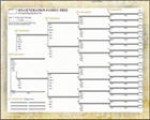 There are a large number of free websites that exist simply for your use in a family history search. These sites contain databases and search capabilities that can quickly aid in determining whether you are on the right path in your search. We suggest you start with a solid Blank Family Tree Template. If you don’t know about it already, it is time to become familiar with the Latter Day Saints’ extensive Web site, which covers parts of Europe, the East Coast and North America for several generations. The Latter Day Saints are renowned for their work in genealogy.
There are a large number of free websites that exist simply for your use in a family history search. These sites contain databases and search capabilities that can quickly aid in determining whether you are on the right path in your search. We suggest you start with a solid Blank Family Tree Template. If you don’t know about it already, it is time to become familiar with the Latter Day Saints’ extensive Web site, which covers parts of Europe, the East Coast and North America for several generations. The Latter Day Saints are renowned for their work in genealogy.
Although records have been found dating back to a person in Europe in 1200 A.D., the Latter Day Saints’ Web site information is not as complete as the CD databases available at public genealogy libraries or at their own genealogy libraries located in most major cities around the world.
Note: In The Step-by-Step Genealogy Guide, we discuss searching public records in detail, including how to get free, professional, one-on-one assistance. The Guide also offers more information abut the LDS website plus provides extensive details about getting the most of an actual visit to the library.
Set a specific goal for each online family history search session (i.e., the one hour you have on Sunday before junior wakes up from his nap) Try to narrow your search and only look at those items that are closely related to your quest. It is possible to spend many fascinating, yet useless hours chasing information. Try to remain focused on your search.
Now Download the full Genealogy Guide and keep your research going!
Genealogy Template Charts
November 13, 2008 by Chris
Filed under Genealogy Reports and Charts, Getting Started, Introduction to Genealogy
 Getting organized is the first and most important step in initiating your genealogy project. A family tree is a chart that outlines the results of a genealogy search. Making a family tree starts with getting your paperwork in order. Starting the search for your own family tree marks the beginning of a private adventure into your personal history. You’ll find delightful surprises, family secrets, and heartaches. The treasures you find will be enjoyed by generations who follow.
Getting organized is the first and most important step in initiating your genealogy project. A family tree is a chart that outlines the results of a genealogy search. Making a family tree starts with getting your paperwork in order. Starting the search for your own family tree marks the beginning of a private adventure into your personal history. You’ll find delightful surprises, family secrets, and heartaches. The treasures you find will be enjoyed by generations who follow.
Getting Yourself Ready For a Genealogy Search
You’ll search for documents that can verify family stories – birth certificates, military records, wills, marriage licenses, and deeds. Therefore, It is a good idea to prepare a notebook to organize yourself.
More Info:
To Organize or Be a Genealogy Slob
By: Rudy Coleman
Click Here to Read This Article(will open in a new window)
Continue reading “Genealogy Template Charts” »
More:How to Make a Family Tree
November 13, 2008 by Chris
Filed under Genealogy Reports and Charts, Getting Started, Introduction to Genealogy
 Making Your Family Tree Chart is as Easy as 1-2-3! First, understanding exactly what a family tree is and what it looks like by downloading genealogy charts. This will provide clarity and direction. You are the first entry, then your parents, then your grandparents. If you have supporting documents, write in ink, otherwise, use pencil. Once you’ve exhausted your resources at home, it’s time to start searching online and elsewhere.
Making Your Family Tree Chart is as Easy as 1-2-3! First, understanding exactly what a family tree is and what it looks like by downloading genealogy charts. This will provide clarity and direction. You are the first entry, then your parents, then your grandparents. If you have supporting documents, write in ink, otherwise, use pencil. Once you’ve exhausted your resources at home, it’s time to start searching online and elsewhere.
Simply follow these three simple steps and you’ll be up and running with your family tree in no time. Start by getting yourself a Blank Family Tree Template
The Step-by-Step Genealogy Guide
- Family Tree Templates
- Exactly How To Make a Family Tree Chart
- Where to Find Birth, Death, and Marriage Certificates
- How to Deal With Name Related Issues Like Spelling Changes.
- And much more . . .

